If you have even a passing interest in anime there’s a very high chance you know that Studio Ghibli’s latest offering, The Secret World of Arrietty, opens in U.S. theaters this Friday. What’s perhaps more surprising is that us fans here in the UK had the unusual pleasure of first seeing the movie back in July of 2011—and, in fact, the Blu-ray/DVD was released here last month. It’s unusual because us poor limeys usually have to play second fiddle when it comes to anime releases; economies of scale and the niche nature of anime fandom mean that we often miss out on some releases altogether, and can find ourselves waiting for up to 6 months after U.S. releases for the ones we do. So what makes Arrietty so different?
The main reason is probably the source material. Based on Mary Norton’s series of Borrowers books, The Secret Life of Arrietty (named simply Arrietty on this side of the Atlantic) draws on one of the U.K.’s best known and loved children’s franchises. Norton’s books have been a firm children’s favorite since their first publication in the 1950s, spawning sequels, stage productions, movies and TV shows—the most recent of which aired just this Christmas on the BBC starring Christopher Eccleston and Stephen Fry. Faced with such a recognizable brand it’s unsurprising that UK distributer Studio Canal decided to push ahead with releasing the movie here—usually they would wait until Disney (who have to rights to Ghibli movies in the US) completed their dub before putting the movie out, but this time have taken the plunge and recorded their own. The result is not just an early release, but also a Ghibli movie with two distinct voice casts and treatments.
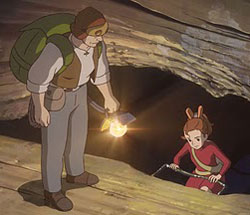 For those of you not familiar with Norton’s books (and a quick straw poll on Twitter suggests they are not quite as well known in the US as they are in the UK) they deal with a race of tiny little people who live under the floorboards in humans’ houses, and “borrow” items from the “human beans” in order to survive, while keeping their existence hidden from them. The movie—like the books—centers around the eponymous Arrietty, who lives with her mother and father, and as the action begins is about to embark on her first borrowing—a night time expedition in to the human world to scavenge for useful items.
For those of you not familiar with Norton’s books (and a quick straw poll on Twitter suggests they are not quite as well known in the US as they are in the UK) they deal with a race of tiny little people who live under the floorboards in humans’ houses, and “borrow” items from the “human beans” in order to survive, while keeping their existence hidden from them. The movie—like the books—centers around the eponymous Arrietty, who lives with her mother and father, and as the action begins is about to embark on her first borrowing—a night time expedition in to the human world to scavenge for useful items.
The major difference is that Arrietty transfers the action from 1950s England to modern day Japan—a slightly unusual move from Ghibli, who have in the past relished in fantasy-European settings for productions like Porco Rosso and Kiki’s Delivery Service. When questioned about this in an interview on the Blu-ray, anime legend and Arrietty screenwriter Hayao Miyazaki claims—with palpable regret—that contemporary Japanese audiences have become insular and uninterested in the world outside their country, and it would be hard to get them to care about a movie set in England.
This leads us to an important point about Arrietty—as mentioned above, Miyazaki is the movie’s writer. He is not its director. That responsibility falls to Hiromasa Yonebayashi—and judging by the aforementioned interviews on the BD it was a hell of a responsibility to take on. For a start Miyazaki has been wanting to make a Borrowers animated movie for some time—decades in fact—but the lengthy processes involved in making his masterpieces means that he’s not been able to make every project he’s had planned. Another notable example of this was Tales from Earthsea — based on Ursula K. Le Guin’s Earthsea books—another series close to Miyazaki’s heart, and that for scheduling reasons ended up being handed to his son Goro. The result was not only Ghibli’s weakest movie to date, but also a falling out between father and son that reportedly led to them not speaking to each other for over a year.
And if that level of potential disapproval isn’t enough, Yonebayashi had even more responsibility to shoulder. The great Miyazaki is getting old—he just turned 71 last month—and his retirement from directing could be imminent. Every movie he announces he’ll make is rumored to be his last, and as the clock ticks on his bowing out becomes inevitable. But as the creative driving force behind the studio—and in many ways its personification—for the best part of three decades, Japan’s cinema going public, animation fans worldwide and the studio’s staff themselves are looking to see if there will be anyone capable of picking up the baton. At 38 years old and with a formidable animator’s resume, Yonebayashi may not seem that inexperienced, but he’s the youngest person Ghibli have let helm a feature yet—and he represents a new generation of directors the studio must nurture if it is too survive into the 21st century.
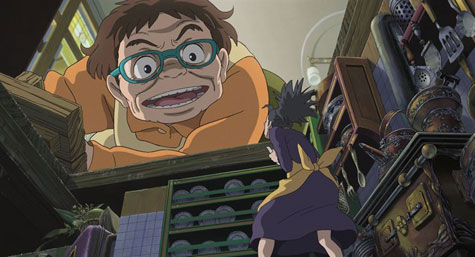
So, an unenviable task for Hiromasa Yonebayashi. The important question is: how did he do?
It’s clear from the very first frame of animation that at the very least Arrietty is technically the equal of any of the Ghibli releases of the last decade or so. In fact, as the story progresses it becomes beautifully apparent as to why Miyazaki had for so long wanted to tackle this story; the world of The Borrowers—or more accurately their unique perspective on our world—fits Ghibli’s unique, ultra-detailed style of animation perfectly. The movie is a joy to watch based simply on how it depicts the four-inch high characters interacting with the world, and how they take human sized objects and repurpose them to fit their needs. Never before has a Borrowers adaptation conveyed the sense of scale—and thus frequent peril and excitement—so convincingly, and combined with glorious background art from famed Ghibli artist Kazuo Oga and his team it’s hard to deny that this is visually the best depiction of the source material to date. Quite simply it becomes apparent that Arrietty is a shining example of a story that works far better as an animated work; no amount of expensive digital effects or elaborate sets would ever make a live action adaptation as enthralling or convincing as the work Yonebayashi has done here.
And it’s not just the visuals either—one of the standout features of Arrietty is the sound design, something anime (perhaps even including previous Ghibli works) arguably doesn’t devote enough time and energy to. The ticks of clocks boom and echo and the fall of human footsteps reverberate, all enhancing the palpable sense of scale and tension and convincing the viewer that they have been shrunk down to this new, unfamiliar size.
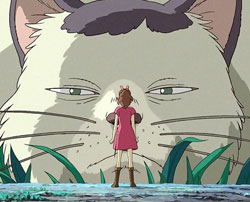 Connected to this is also the dub—and as I mentioned at the top of this review this is where I can only comment on Studio Canal’s adaptation. Dubs themselves are a frequent bone of contention and debate amongst anime fans, but with Ghibli films being aimed at primarily a younger audience subtitles are not really an option for theatrical releases. Luckily with Disney usually at the helm the studio’s releases have been treated to voice casts made up of well-known and talented actors—the US dub for Arrietty includes Bridgit Mendler, Carol Burnett, and Will Arnett. The UK dub isn’t anywhere near as star studded—it’s most recognizable name being Mark Strong, probably best known for his roles in Kick-Ass, Tinker Tailor Soldier Spy, and Sherlock Holmes, but it’s still an effective and highly professional collection of performances, with its English accents reminding viewers of the book’s original setting despite the often Japanese touches of the visuals.
Connected to this is also the dub—and as I mentioned at the top of this review this is where I can only comment on Studio Canal’s adaptation. Dubs themselves are a frequent bone of contention and debate amongst anime fans, but with Ghibli films being aimed at primarily a younger audience subtitles are not really an option for theatrical releases. Luckily with Disney usually at the helm the studio’s releases have been treated to voice casts made up of well-known and talented actors—the US dub for Arrietty includes Bridgit Mendler, Carol Burnett, and Will Arnett. The UK dub isn’t anywhere near as star studded—it’s most recognizable name being Mark Strong, probably best known for his roles in Kick-Ass, Tinker Tailor Soldier Spy, and Sherlock Holmes, but it’s still an effective and highly professional collection of performances, with its English accents reminding viewers of the book’s original setting despite the often Japanese touches of the visuals.
If there is one area where perhaps The Secret World of Arrietty falters it is in it’s story and pacing. As beautiful and engaging as the world is visually, there’s a creeping suspicion at times that not enough is happening. Yonebayashi has created an amazing playground, but you can’t help wishing at times that Miyazaki’s script would let his characters play in it a little more often. Ghibli movies are famed for their often slow and gentle pace—but it’s easy to forget how they balance this with exhilarating action—Porco Rosso’s dogfights and Princess Mononoke’s battles spring to mind, or even My Neighbor Totoro’s flying sequences. Arrietty has hints of these, but nothing really boils over in to the full on adventure that the elaborate and compelling setting seems to demand. Not that the film lacks emotional cues—there are convincing moments of peril as Arrietty and her family risk being spotted by the gigantic humans, and the sickly human boy she befriends risks his health to save them—but it’s hard to shake the feeling that the story needs one or two more high points.
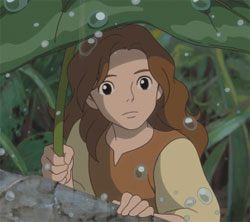 So what of Yonebayashi, and thus Ghibli’s future? If anything is clear it’s that the studio has another talented director in its ranks—The Secret World of Arrietty is an impressive and accomplished debut by anybody’s standards. Indeed in many ways the film feels like the best work the studio has produced since Spirited Away in 2001, which is not just a bold statement but a truly exciting development. It will be exciting to watch Yonebayashi what does next, and if the Studio Ghibli has any sense it’ll loosen his reigns some more and allow him and his colleagues to venture out of the great Miyazaki’s shadows and take some risks of their own.
So what of Yonebayashi, and thus Ghibli’s future? If anything is clear it’s that the studio has another talented director in its ranks—The Secret World of Arrietty is an impressive and accomplished debut by anybody’s standards. Indeed in many ways the film feels like the best work the studio has produced since Spirited Away in 2001, which is not just a bold statement but a truly exciting development. It will be exciting to watch Yonebayashi what does next, and if the Studio Ghibli has any sense it’ll loosen his reigns some more and allow him and his colleagues to venture out of the great Miyazaki’s shadows and take some risks of their own.
When he’s not writing for Tor.com, Tim Maughan writes science fiction—his critically acclaimed book Paintwork is out now, and has been picking up support from the likes of Cory Doctorow and Ken MacLeod. So you should probably go buy it already.










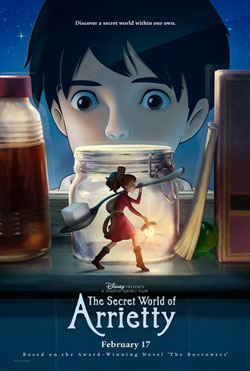
Hey Tim,
I believe Tomomi Mochizuki was actually the youngest director for Studio Ghibli when he directed “Ocean Waves” at 34. But, that was a made-for-tv production so I may just be splitting hairs.
Anyway, kudos on the great article. It certainly makes me want to check out the film. Sorry for being “that guy”.
I was a huge Borrowers fan as a kid (growing up in the UK though, so I think I’m only supporting the results of your straw poll) and this sounds great! Thank you so much for bringing it to my attention. I’d be interested in seeing a comparison between the UK and US versions, if you happen to end up catching both:) (Yes, out of sheer laziness, I want someone to tell me which one to watch.) My inclination is to trust the UK one because a) I am British and b) with such a British canon, I’d assume it would at least feel more “realistic” with British voices, but the acting quality can make such a difference too.
@colin J
Oh, good call. I didn’t realise he was that young when it came out. But like you say it was for TV and I was thinking more of movie features…well that’s my excuse and I’m sticking with it :P
@supertailz Are you in the UK? Then I’d go with the UK version. You can pick it up easily and for fairly cheap on DVD or Blu – I think they’ll be quite a wait for the US release. But if you’re in the US go and see it at the theatre! It looks great on the big screen.
My whole family is really looking forward to seeing it, but how could I have seen so many trailers for it and never before noticed the cameo by Dr. Otto Octavius?
Seriously. Look at the third image in this review.
Veeeeeeeeeeeeeery interesting. Ghibli has been trying to train up a new generation of directors since the early 90’s, but they all seem to do one movie and then retire, or leave for another studio, or just stop directing. They’ve never been able to make a non-Miyazaki director stick around as a studio mainstay. I wonder if that isn’t partly because Miyazaki is there? Maybe it’s hard to start a career when the other director at your studio is freaking Hayao Miyazaki.
@5
I wouldn’t be surprised. From the little bits of news and those ‘behind-the-scenes’ clips on DVD releases, Miyazaki probably has a lot more fingers in the pie than his official titles suggest. And how do you argue with The Master when any argument basically boils down to ‘I think it’d be better this way’?
I’d love to see the UK version, and the American is wondering how she can get her grubby little paws on it…
Also adding to the pressure Hiromasa Yonebayashi must have felt was how Mamoru Hosoda (also in his mid 30’s at the time) was brought in to make Howl’s Moving Castle and then got taken off the project. Though I have to say that it’s Studio Ghibli’s lost because he went to Madhouse and created The Girl Who Leapt Through Time and Summer Wars and his new The Wolf Children Ame and Yuki looks awesome.
@steelbound
I saw The Girl Who Leapt Through Time and was slightly underwhelmed, but enjoyed it overall (it may have been over-hyped by a couple of my friends). How is Summer Wars? I might have to track that down.
I recall that The Borrowers books were talked about by fellow kids in my school years on Long Island. Not my cup of tea personally, but I remember enjoying a TV-movie adaptation. (There was an animated version too . . . late 70s or early 80s?)
I’m split over whether to see this adaptation in the theater. On one hand, it looks decidedly like a kids’ movie. On the other hand, I went to see Ponyo on impulse, and while I almost snoozed off early on I ended up walking out of the theater with the biggest goddamn grin.
There was also a film adaptation in 1997 starring John Goodman. I didn’t see it, but I read the books as a kid in the 1970s. One of the advantages of living in Canada is that we are exposed to far more British culture (books, films, television) than Yanks.
I am really looking forward to this movie. I read the Borrowers as a kid in California and loved the books. I have not been as interested in the adaptaions preivious to this but I have faith in Studio Ghibli.
As a side note I grew up in California to ordinary American parents and read plenty of general British fiction. I even knew what a philosopher’s stone was and found the Americanization to be kind of insulting.
But I grew up with parents who taught us that if you did not know what something was you learned about it. you did not give up on it.
Oh well, Yay for this movie and I will see it when it comes out.
(and then buy the DVD)
I’m surprised that you consider Bridgit Mendler as Arietty a better-known actress than Saoirse Ronan. I’d never heard of Mendler, and she seems to appear mostly in TV roles, while Ronan has had the lead in a number of films, including Hanna and The Lovely Bones, not to mention an Oscar nomination.
I agree pretty much point for point with this review. I’d add that I thought the music was just lovely and meshed so very well (and had a lovely background story as well). What I loved most about the film was the attention to detail that made the world so very convincing. Their food and drink especially, the whole sense of scale that brought was amazing.
I really loved this movie. I had no trouble with the lack of a full-on adventure plot– it’s basically just the first book (plus one character from the second), which spent a lot of time just establishing their world and letting you think about how cool it would be to be a borrower. I think that’s something kids often care about more than epic events, and it works fine for me now too. I guess they could’ve combined it with more of the plot from The Borrowers Afield, but I don’t think that would’ve been worth losing all of the great texture and the contemplative moments.
In the US dub, I thought the voice actors were fine although the performances of Arrietty’s mom and the housekeeper were a little over the top– but judging by the way they’re animated, I’d guess that’s also true of the Japanese version. I could’ve done without the theme song, especially since the sound design in general is, as Tim noted, awesome.
I can’t remember: in the book, does the boy have such a fatalistic attitude? In the scene on the lawn, what he says about his illness is something I can’t imagine hearing in any American children’s cartoon, but it’s the kind of thing I love about Miyazaki’s characterizations: he’s willing to give full weight to really unpleasant emotions, while at the same time showing that there’s more than one way to handle them.
Oh yeah, also: as a science nerd, I got a huge kick out of some of the details of how a miniature world works, which aren’t pointed out or explained at all but might get a curious child thinking. For instance, all the liquids– tea, soup, even Arrietty’s tears– form into round blobs due to surface tension. Also, although I didn’t get a good look at it, I think Pod’s portable light is powered by a homemade battery made from nickel and copper.
A good review with a couple of startling revelations –
“Indeed in many ways the film feels like the best work the studio has produced since Spirited Away in 2001”
Did you see Ponyo? Because if you did, I don’t think you’d be making this statement. Ponyo is a far superior movie to Arriety, from story construction, soundtrack and pacing to it’s simply amazing art direction and pure cinematography.
“The UK dub isn’t anywhere near as star studded.”
Bridgit Mendler, Carol Burnett versus Mark Strong and Saorsie Ronan? Are you serious? I’ve never even heard of Bridgit Mendler, and I vaguely recall Carol Burnet as some vulgar comedienne past her prime… Perhaps I’m missing something here?
took the fam to see this this weekend. it was great. beautifully done. the kids liked it too.
btw – does anyone remember “the littles” cartoon?
Took the family to see it this weekend; we adults thought it worked on many levels. The story was engaging, the animation was beautiful; I pointed out to my science-studying daughter the surface-tension thing on the drops [what a nice detail!]
The only problem I had, and I admit that it may be because I’m not used to anime, is the fact that all the characters that we were to be sympathetic with clearly looked western. The exterminators looked Japanese [one even had the stereotype thick glasses] and most troubling to me the housekeeper, clearly the villain of the piece, looked very “ethnic” and almost animalistic [“bestial and simian” was the comment I heard from a family member].
Again, maybe this is because I don’t watch much anime, but I was very troubled by this; my [12 and 14 yo] kids picked up on this and said they thought it was kinda racist.
Am I over-reading?
It would be interesting to compare this with another Ghibli book-to-movie adaptation, Kiki’s Delivery Service. (Sadly, the Kiki’s Delivery Service novels haven’t been translated into English — they’re quite charming in their own right). The first Kiki’s Delivery Service novel included many of the same incidents as the movie, but the tone was gentler overall, with fewer moments of peril and (especially) fewer moments of genuine emotional distress (I’m not sure if the zeppelin rescue at the end shows up in one of the novels that I haven’t read yet, but it’s not in the first one — neither is Kiki losing her ability to talk to Jiji, and her subsequent despair). It sounds like this movie took a lot fewer risks in adapting a gentle, quiet text for a mode of storytelling that demands higher highs and lower lows.
Dr. Thanatos:
I haven’t seen Arrietty, but it’s pretty common for people new to watching anime to think that the characters look white. The first manga artists took a lot of stylistic hints from European and American comic books and cartoons, especially Disney cartoons, and that effect persists today, but to a Japanese person those faces read as Japanese. (Americans are drawn differently, usually with larger noses.)
@15 I agree- Ponyo was wonderful.
@16 I remember The Littles cartoon. I loved it when I was young, but I never knew it was based on a series of books.
I have to admit that I wasn’t crazy about Arrietty. It looked beautiful and the music was amazing, but it felt very slow to me. My niece and sister both fell asleep before the movie was even halfway through. My favorites from Studio Ghibli are Princess Mononoke, Howl’s Moving Castle and Spirited Away.
@Emily,
But doesn’t the character of the housekeeper look drastically different than everyone else?
The rumors I hear say that Porco Rosso’s sequel is going to be Miyazaki’s meditations on old age; I really hope it happens.
Saw it a few days ago. It was marvelous.
@@@@@ supertailz
I’ve watched both the US and the UK version and I prefer th US version. This has nothing to do with the accents but the fact that both versions are not the same word for word. For that matter they go father than not even just adding in reginal slang and terms. There are whole frases that are changed that I feel are much stronger in the US version and that is probably do to better writers. Disney typically uses their Pixar team for these dubs which I trust much more than Studio Canel which granted I’ve seen a lot of good dubs come from them.
Secondly I find that the performances of the US voice cast is much better. This isn’t nessisary do to any weaker actors but possibly a better voice over directors.
Bottom line if you have the option to watch either version if go with the US version.
This is simply a wonderful and beautiful story.
Hayao Miyazaki just knows how to make the best of everything, from Totoro to Ponyo; Kiki’s Delivery Service to Spirited Away and even more~ :)
does anyone know if theyll possibly make a sequel to this? the ending was kinda huge letdown they could make an amazing sequel to this film
am i the only one who enjoyed Howl’s Moving Castle more than Ponyo? I actually happened to feel that it, more than any other of the Ghibli features i’ve seen in the last decade was a little too.. kiddy for me. I just didn’t find it engaging the way I have many of his other works that had a strong pedigree as children’s tales, from Spirited Away to Kiki.
By the way, in my opinion- if you can see it, see it subbed. Even with big budgets, I feel that the position and cultural status of Japanese voice actors fits the medium better than the dubs I’ve seen. Probably cowboy bebop is the BEST dubbing work i’ve heard, and I did love Billy-Bob as the little guy in Mononoke but even still, I like the japanese language dubbing better. maybe because i don’t speak japanese everyday and have a harder time telling when it sounds shlocky… i dunno. but lets face it, there’s no american or brit who’s gonna scream like shinji lol.
@dinokun, I loooooove Howl’s Moving Castle. I found Ponyo to be too slow moving, and the animation didn’t see up to par as HMC. That said, I loved the detail in Arriety, though I found it slow-moving as well.
@Dr. Thantos, it does seem that the older villians in Ghibili films are based off of oni, or demons, with their protruding eyes and wide mouths. The old monk in Princess Mononoke is drawn the same way, And now that I think of it, so is the old witch in Spirited Away (which is interesting because the witch has a twin sister who looks exactly like her, but turns out to be caring and sweet. She’s got a wicked sense a humor though). So I think it’s more of a Japanese thing.
And @Petar, Carol Burnett was never vulgar! Her TV show in the 70s was considered one of the last great variety shows. She worked with with Tim Conway and Harvey Corman, and the three of them would try to crack each other up during the show’s sketches. She also did parodies of movies–one of my favorite sketches I remember is when she did an entire show parody of Gone With the Wind. Had me in stitches when I was a kid.
But check out some of her stuff on YouTube. Very family-friendly, very funny.